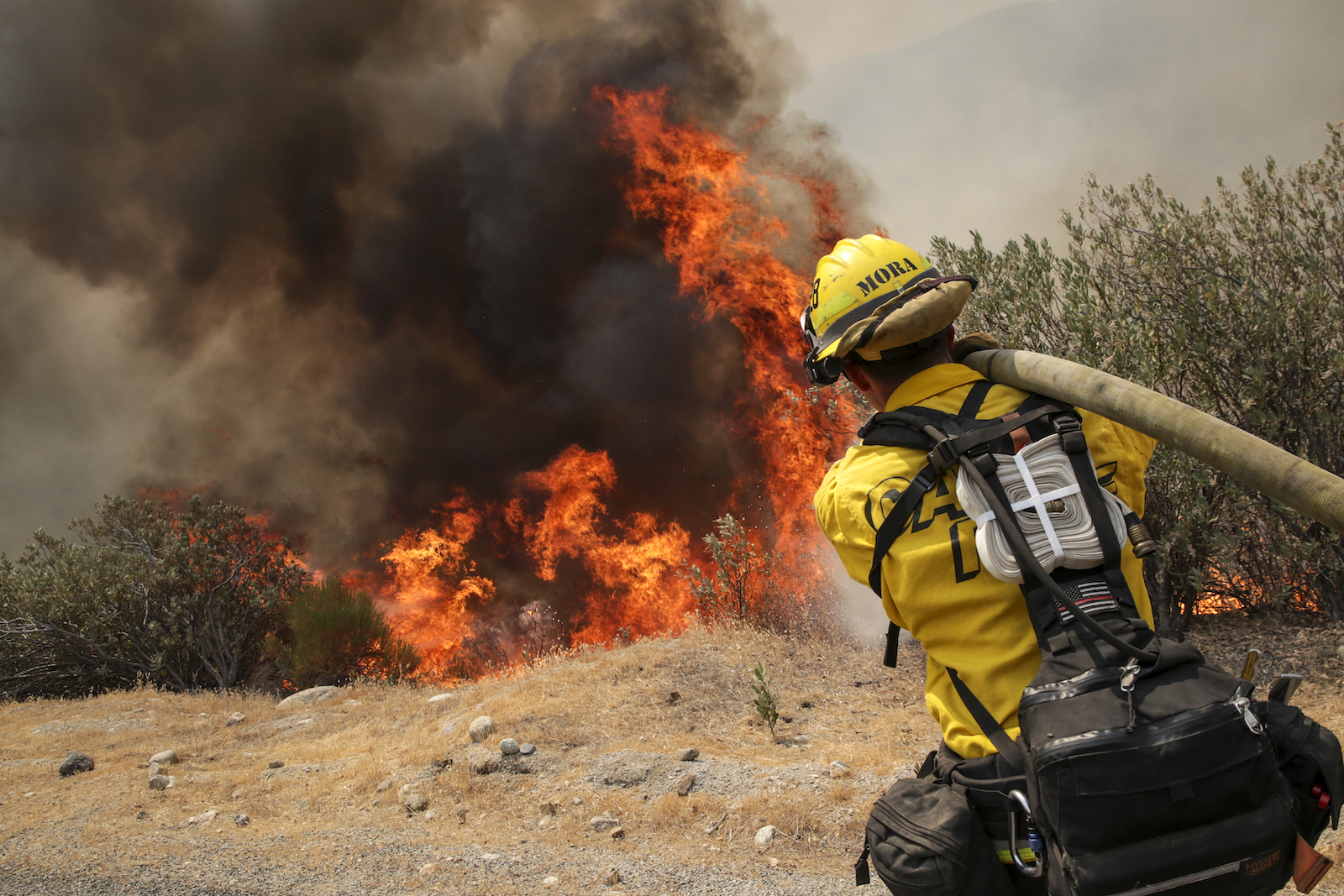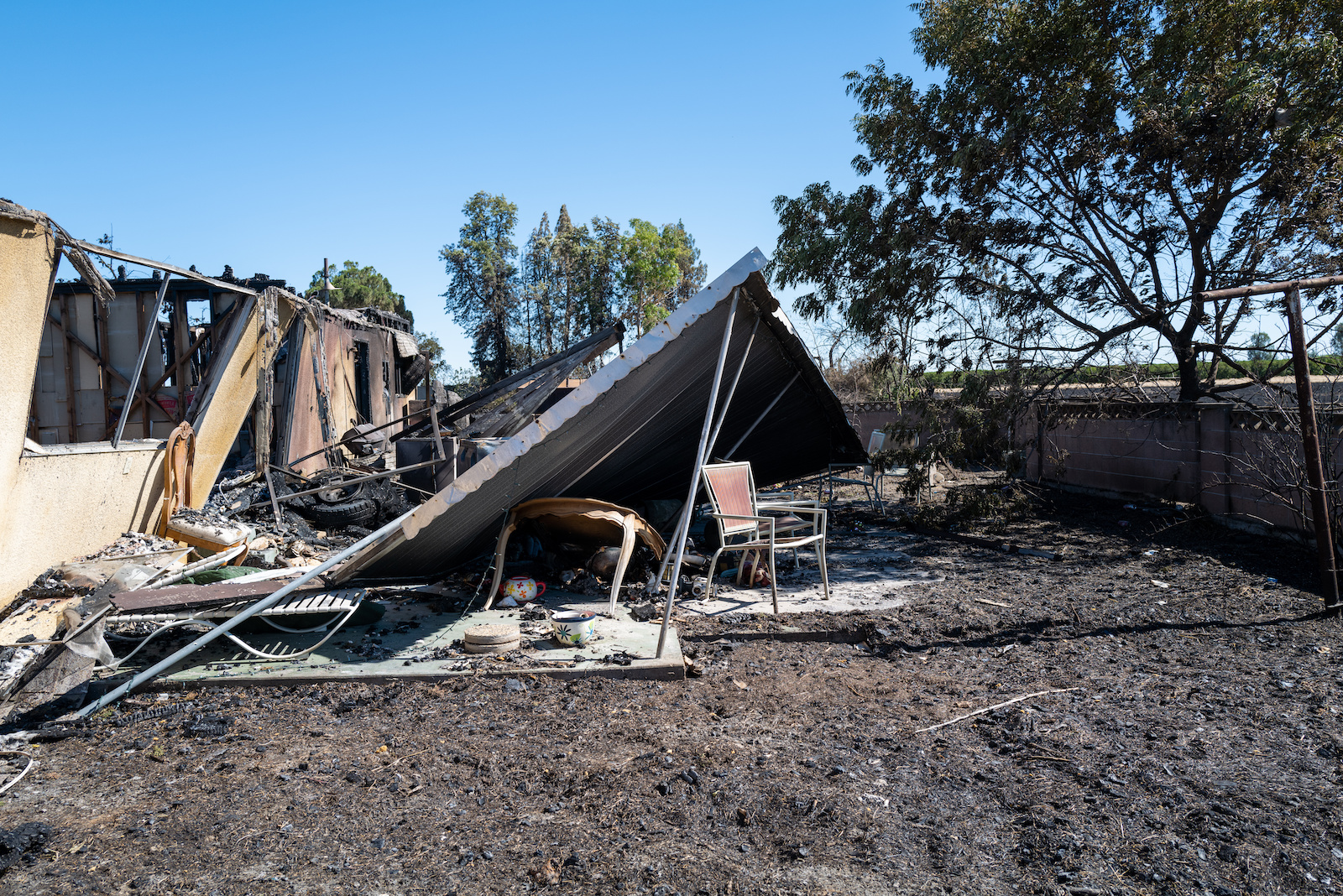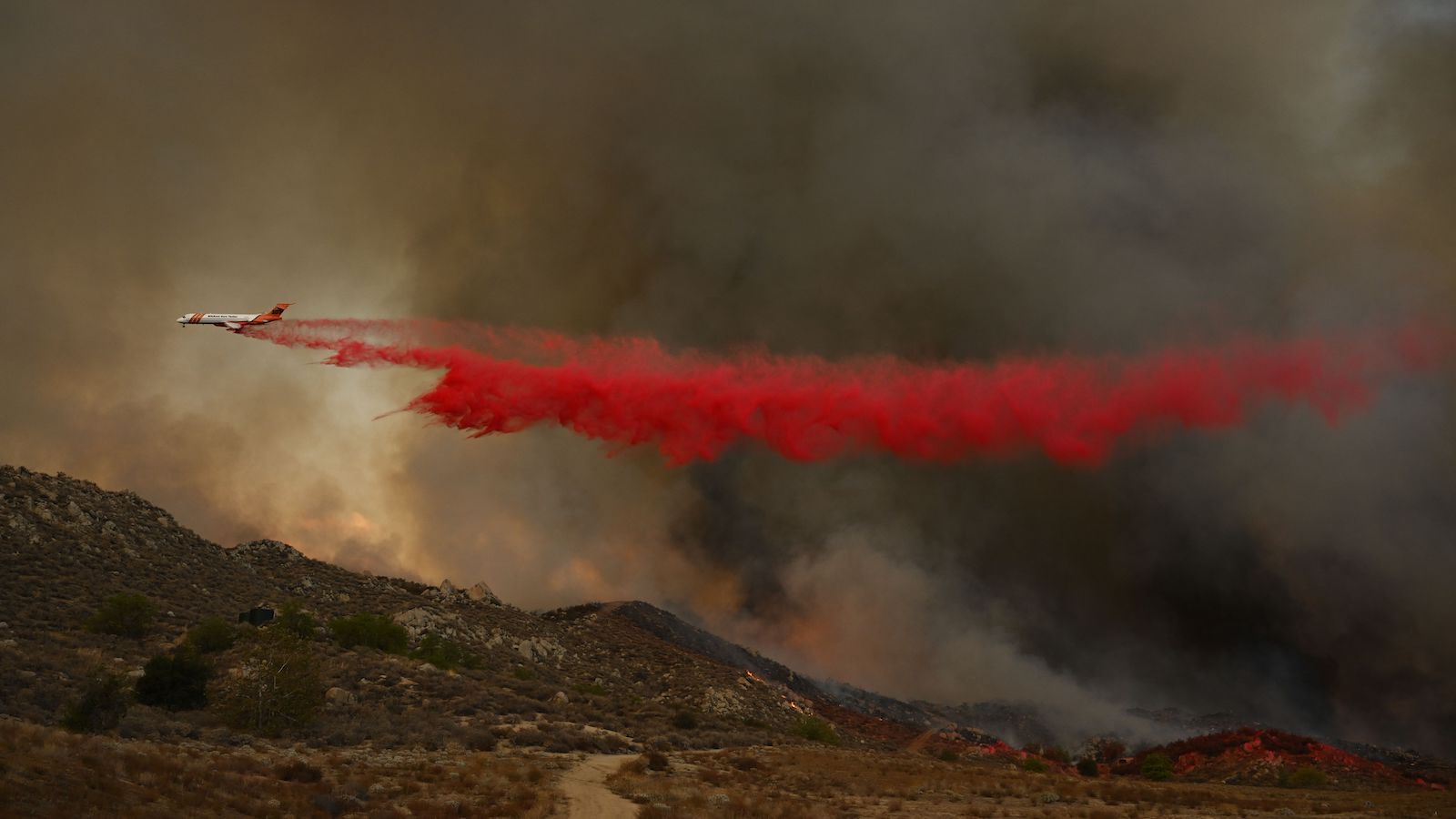This story is published collaboratively with the California Health Report as part of the Equitable Cities Reporting Hub for Environmental Justice, an initiative led by Grist and Next City.
Tania Pacheco-Werner put on her walking shoes. She was halfway through her first pregnancy and had just been diagnosed with gestational diabetes. Her doctor’s advice? Stay active.
But Pacheco-Werner lives just outside Fresno. It was summer, and well over 100 degrees Fahrenheit. The air outside was also thick with wildfire smoke from nearby forest fires — an increasingly common occurrence due to climate change.
The expectant mother wanted to do everything right, but was getting conflicting advice. On the one hand, she needed to walk and stay active to prevent complications from gestational diabetes; on the other, public health messaging about wildfires told her to stay inside and reduce her exposure to the smoke. So, what did she do?
Pacheco-Werner went to Walmart. Every day, her husband drove her to the nearby superstore so she could walk around and exercise indoors where the air felt cool and clean thanks to air-conditioning and filtration.
Her doctors hadn’t instructed her to come up with this solution. In fact, her doctors never advised her about the potential effects of wildfire smoke on her pregnancy. But Pacheco-Werner holds a PhD in medical sociology, is the co-director of the Central Valley Health Policy Institute, and also serves on the Board of the California Air Resources Board for the San Joaquin Valley. She had been closely following a growing body of scientific literature about the impacts of wildfire smoke on preterm birth and adverse birth outcomes.
Thanks to her own research, Pacheco-Werner knew to buy an air filter to make her home safer for herself and her baby. She knew that finding a safe space to exercise was important for a healthy pregnancy. But looking at the cloud of smoke hanging over Fresno, Pacheco-Werner suspected many other pregnant people were also in danger.
Those most at risk were likely the people living in substandard housing, a problem tied to historically exclusionary policies in the region. As research increasingly shows how wildfire smoke and poor air quality hurt pregnant people and the children they carry, cities across California are working to curb these effects through ventilation centers and weatherization programs. In Fresno, where the air quality is routinely some of the worst in the country, the city and its residents are grappling with how to keep up with the increased risk of severe wildfire smoke.
Since the beginning of the 20th century, the bulk of Fresno’s affordable housing —and, in turn, its low-income populations and many people of color — have been located on the city’s west side. Government policies codified housing discrimination in the 1930s with “residential safety maps” that aimed to help investors decide which areas were “safe investments.” They marked the “least desirable” neighborhoods in red, which became the basis for the term “redlining.” In many instances, Black people living in these redlined neighborhoods were denied home loans altogether. West Fresno was one of these redlined districts, and the homeowners there have been feeling the repercussions ever since.
The idea that present-day health problems can be traced back to redlining is not new, nor is it exclusive to wildfire smoke. In a 2020 study by the UC Berkeley–UC San Francisco Joint Medical Program, researchers found that historically redlined areas of eight cities in California — including Fresno — have “significantly higher rates of emergency department visits due to asthma.” The study analyzed several factors that might contribute to health problems in redlined areas, including emissions from highways, which are found more frequently near low-income neighborhoods. The study also briefly noted that, under racially exclusionary housing practices, Black families lacked access to well-constructed housing.
“Areas that were redlined have been shown to have houses that are of poor quality,” says Rachel Sklar, a post-doctoral researcher at the UC San Francisco’s Program on Reproductive Health and the Environment. Sklar is trying to understand the links between redlining and birth complications for pregnant people in California. She explains that, because older houses tend to have older windows, poor-quality insulation and no air conditioning (requiring inhabitants to open windows), these homes likely also harbor more air pollution, including wildfire smoke. That means residents of these homes might face higher rates of pollution exposure.
A 2005 study from the University of California Berkeley analyzed housing characteristics that may lead to “leakage” of air pollution into the home. The study found that older and smaller houses tended to have more leakage than newer and larger ones, which are more likely to have weather-stripped windows and incorporate modern building techniques. Another study, from 2001, found that there could be a tenfold difference in leakage between the homes with the best air tightness and those with the worst.
Air pollution of all types is a problem for these “leaky” homes. But as wildfire smoke increases in both severity and intensity in places like Fresno, public health messages are failing to address inequalities in housing standards. According to a report titled “Wildfire Smoke: A Guide for Public Health Professionals” compiled by the Environmental Protection Agency, “the most common advisory during a smoke episode is to stay indoors, where people can better control their environment.” However, the authors explained that the effectiveness of staying indoors as a strategy “depends on how well the building limits smoke from coming indoors.” The authors acknowledged that access to air conditioning is helpful to reduce indoor smoke, but many low-income households don’t have access to it.

“In very leaky homes,” the report found, “outdoor particles can easily infiltrate the indoor air, so guidance to stay inside may offer little protection.”
In the summer of 2018, when Pacheco-Werner was pregnant, the county of Fresno issued a health advisory about the wildfire smoke and extreme heat. In this advisory, the county advised “people with existing respiratory conditions, young children, and the elderly” to “remove themselves” from smoke. The California Department of Public Health, or CDPH, has issued similar warnings in summer months, urging people living near wildfires to “stay indoors if possible.” While the CDPH notices do state that pregnant people like Pacheco-Werner are especially vulnerable, no alternatives are given to account for variations in indoor air quality or access to filtered air.
Exposure to dangerous levels of wildfire smoke has increased significantly over the last decade. This is true for most of California and much of the western United States, but Fresno has been hit particularly hard. According to the air quality tracking website IQAir: “Smoke that travels from wildfires throughout the state often reaches the Fresno area and worsens the city’s already poor air quality, often increasing air pollution levels significantly.”
Researchers are studying the impact of Fresno’s poor air quality on children, including those exposed prenatally. The Children’s Health & Air Pollution Study is a collaboration between Stanford University and UC Berkeley that has published numerous studies assessing the effects of various sources of air pollution on children’s health, including a 2020 review of the effects of wildfire smoke. The authors cited a single day in 2018 when over 1 million school children in California had classes canceled due to wildfires. Children are particularly susceptible to smoke, they wrote, because they tend to spend more time outside, breathe more air relative to their body weight, and are still growing and developing. The researchers advised that ventilation and filtration be improved in all buildings in which children spend time. They also noted that children’s risk of health problems due to wildfire smoke doesn’t just start when they head off to school: Problems can arise while they’re still in the womb.
Researchers have recently sought to better understand the effects of wildfire smoke on pregnant people. In 2021, Stanford researchers, led by Sam Heft-Neal, published a study that linked wildfire smoke to preterm births across California. Heft-Neal and his team were able to demonstrate that every additional day of smoke exposure was linked to an increased risk of preterm birth, concluding that nearly 7,000 “excess preterm births” in California could be attributed to wildfire smoke exposure in the study’s five-year period.
Preterm birth is typically defined as birth before 37 weeks of pregnancy. According to the Centers for Disease Control and Prevention, babies born prematurely are at risk of a variety of health complications, including breathing problems, feeding difficulties, vision and hearing problems, and developmental delays. Additionally, one-third of infant deaths across the state are related to prematurity.
In the United States, the average rate of preterm births is one in 12. But there is a stark divide along racial lines, especially for pregnant people in Fresno County, home to the highest rate of preterm births in California. At least in part due to societal inequities and institutional racism, Black people in Fresno County are nearly 75 percent more likely to have a preterm birth than white people. This statistic led researchers, health experts, physicians and community members to launch the California Preterm Birth Initiative to conduct and fund research on racial disparities in birth outcomes while centering BIPOC lived experiences. According to the Fresno County Department of Public Health, in 2020, the preterm birth rate for white pregnant people in Fresno County was just under 9 percent, but the rate for Black pregnant people was approximately 13.5 percent. For Hispanic pregnant people, like Tania Pacheco-Werner, it was 10 percent, though Hispanic preterm births make up the highest total number in Fresno County, at 821 reflecting the area’s large Hispanic population. Of the total 1,378 preterm births in Fresno County in 2020, 59.5 percent of them were Hispanic.
Linking preterm birth rates to wildfire smoke exposure is complicated, Kendalyn Mack-Franklin of the California Preterm Birth Initiative explains. People of color in Fresno have reported a number of variables that contribute to their high rates of preterm birth, from lack of access to prenatal care, to racism within medical facilities. Environmental exposure likely played a role before the significant increase in wildfire smoke too, since redlined neighborhoods in Fresno are closer to freeways and pollution-emitting industrial zones.
“Preterm birth has a lot of confounding variables,” Mack-Franklin says. “It’s very difficult to say that it’s for one particular reason, unless that reason is
In 2019, the California Legislature approved the Wildfire Smoke Clean Air Centers for Vulnerable Populations Incentive Pilot Program. The program, administered by the California Air Resources Board, will build a system of clean air centers by funding ventilation system upgrades in schools, community centers, senior centers, sports centers and libraries. Funding will be divided between California’s three air quality districts (Bay Area Air Quality Management District, San Joaquin Valley Air Pollution Control District and South Coast Air Quality Management District) and the California Air Pollution Control Officers Association which oversees all 35 local air quality agencies across the state. In the San Joaquin Valley District, applications for funding opened on Aug. 17.
Clean air centers are one way to tackle the problem of indoor air quality, but to Rachel Sklar, housing is still at the center of smoke’s disproportionate effects on low-income people of color. “The problem is that people have no choice but to live in poorly maintained homes,” she sats.
Sklar adds that while coastal cities like those in the Bay Area might routinely have better air quality than inland regions, low-income residents of those cities are being pushed inward to places like Fresno as their housing costs become untenable. In her most recent paper, published Aug. 28 in the International Journal of Gynecology & Obstetrics, Sklar calls for housing policy reform, writing, “The rapid population growth in inland areas with high fire risks, as well as the disproportionate share of low-income black and Hispanic people that are migrating to these areas and experiencing the downstream health effects of living in those areas must be addressed.”
While redlining and residential safety maps may technically be relics of the past, Sklar notes that today’s housing crisis is pushing low-income people to “sub-optimal living situations where their health is going to be affected.”
“Who would think that urban housing policy would have anything to do with preterm birth rates?” says Sklar. “Well, you wouldn’t, unless you connect the dots.”

Air quality districts around the state are starting to realize the importance of healthy air in homes and have piloted a variety of incentives to find solutions, though improvements in air quality are often one of many benefits of energy-focused programs. The Fresno Economic Opportunities Commission has a weatherization program aimed at helping homeowners and renters cut down on energy costs and prepare their homes for extreme weather by weather-stripping doors, caulking windows and gaps, insulating exterior walls, and repairing and replacement ducts. “Of the residents served within the past year, 56 percent lived in homes 50 years or older,” says Fresno EOC Energy Manager Matt Contrestano. “In addition, almost 23 percent of the homes assessed were deferred services due to the condition of the home including structural, electrical, plumbing, sewage and water leaks or clutter and pest infestation issues.”
In 2021, Fresno EOC’s Transform Fresno project, which focuses on downtown, Chinatown, and southwest corners of Fresno, provided energy-efficient upgrades to 12 homes; in 2020, they reached 34 homes. According to Contrestano, these programs help residents by reducing utility bills, maximizing energy efficiency, and allowing each resident to live in a healthier and more comfortable environment.
In 2021, Santa Barbara County Air Pollution Control District launched a program to give hundreds of free air purifiers to residents in the towns of Guadalupe and Casmalia. This year, the San Joaquin Valley District followed suit, approving a similar program to give 1,500 families free in-home air purifiers to mitigate the in-home risks of wildfire smoke exposure.
Despite the grueling summer months, Pacheco-Werner had a healthy pregnancy and carried her baby to full term. But her son, now 4 years old, has developed asthma, which has been difficult for Pachecho-Werner’s family to manage. There’s no way to know if his asthma is related to the wildfire smoke his mother breathed in when he was growing in her womb.
This past spring, Pacheco-Werner became pregnant again, and she worried that she’d have to endure another summer of hot, smoky weather. So far, the pollution has been moderate, but Pacheco-Werner ended up facing another challenge: Her second baby was born preterm, at 36 weeks. Although she and the newborn are recovering well, Pacheco-Werner is concerned he too will develop asthma like his brother.
Even so, Pacheco-Werner is well aware of the privilege that her fluent English and health insurance afford her. But as a Mexican immigrant who spent much of her life in Fresno’s “most impacted neighborhoods,” she continues to use her personal experiences to inform her research on the relationships between neighborhoods and health, fighting for every Californian to have equal access to clean air.
“When we don’t pay attention to inequality,” she says, “it affects us all.”



